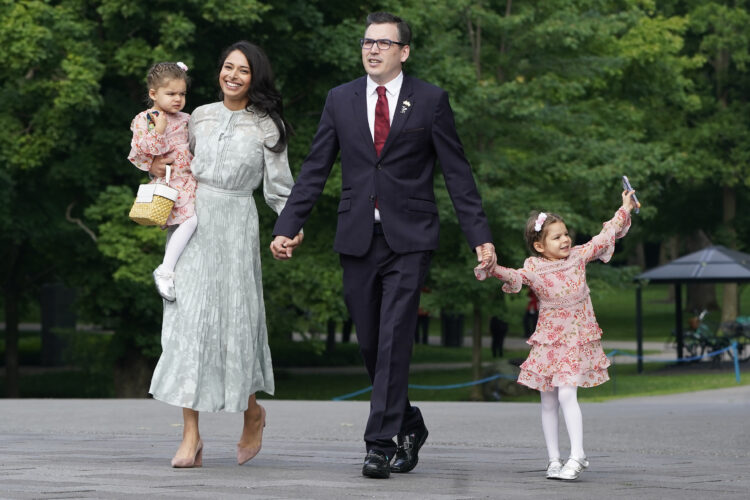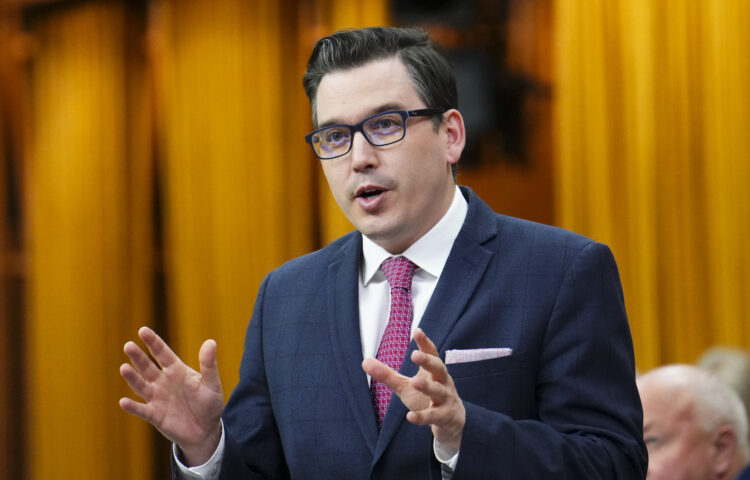
OTTAWA – Terry Beech claims his new job as Canada’s first ever minister of citizens’ services shows the government means it this time. Delivering services to Canadians is a longstanding weakness of government, and he says a big problem is that politicians have had little interest in it.
“I think first and foremost, we just haven’t focused enough of our attention and time on it,” Beech said in an interview.
“This is an opportunity for us to better understand all the systemic challenges that exist, but also to say our government and prime minister is committed to high-quality service delivery. We are so committed, in fact, that we are setting up a new ministry.”
Service delivery has been an Achilles heel of government for 30 years. It’s why Service Canada – which Beech is now responsible for – was created as a one-stop shop for all government services to focus on delivery and citizen satisfaction.
Service has always taken a back seat to policy. Prime ministers, ministers and even deputy ministers pay little attention until a crisis hits. That approach was on full display as Canadians eased out of the pandemic and faced shambolic lineups for passports, immigration and air travel.
Beech acknowledges cabinet ministers haven’t kept a close enough eye on the “end-to-end customer experience.” Cabinet puts all its effort into making policy decisions and assumes they will be implemented and delivered the best way possible.
As minister, he will make sure delivery will be part of policy discussions from the start. That way, ministers will have a better handle on what government does well and what it doesn’t, which will reduce snags or setbacks when services are rolled out.
“Without cabinet ministers having an eye to potential constraints or opportunities to provide exceptional levels of service, those opportunities get missed. Now those opportunities will be front and centre in the discussion.”
Beech founded the company HiretheWorld.com. He understands tech and is customer-oriented, and sees his new job as a natural fit. “This is really an entrepreneurial opportunity.”
He said Canadians’ user experience is his priority, making sure their needs are first and at the centre of all services. (Critics have long argued departments tend to design services around what government does rather than what Canadian want.)
And what do citizens want?
Canadians live digitally when they shop and work and expect the same when dealing with their governments. They want single IDs, digitally issued permits, applications, approvals and information. And they want it fast on their personal devices, 24/7.
They roil when they can’t get the same service ordering a passport as they do when buying from Amazon. Why can’t government track Canadians’ interactions with departments and use that information to improve or customize services?
Beech wants to do all that and more.
“My number one priority probably goes back to my vision for this role, which is waking up every day thinking about how I can improve customer service and the customer service experience for every Canadian,” he said. “That’s literally what’s going to be on the piece of paper that I pull out of my desk every morning and think about as I go into every meeting,” he said.

Waiting to see
All this should be music to the ears of critics who have long pressed for government to put the customer back into service and bring it into the digital age.
So far, reaction is mixed. Public servants are waiting to see what levers and authority Beech will have. The pieces of this new portfolio have started to come together, but there are more to come, including ministers’ mandate letters.
Service Canada opened in 2005 with the vision of a one-stop shop for all government services. It is housed at Employment and Social Development Canada (ESDC) and most of the services it offers are bundled around the benefits ESDC provides – EI, OAS, CPP and disability benefits.
Service Canada also includes the team that runs Canada.ca, the government’s website and digital home. A new order-in-council transferred the Canadian Digital Service (CDS), a swat team of tech geeks, from Treasury Board to ESDC.
A chief service czar with access to the government’s digital swat team, “could be a pretty big deal,” according to Aaron Snow, the former CEO at the digital service.
But the devil will be in the details, tweeted Ryan Androsoff, founder and CEO of Think Digital, a consulting firm on digital transformation.
“I think even the most well-intentioned person is being set up to fail if they don’t actually have the authority to make change across that entire service spectrum,” he said in an interview.
It’s unclear whether Beech will have authority to direct departments, such as Canada Revenue Agency, Parks Canada or the Canada Border Services Agency, which also provides services. As services improve, Beech hopes other departments will want Service Canada to deliver its services.
The growing fear among digital-government advocates is that CDS, created to help all departments improve their services, will move to ESDC and die.
The big question is whether CDS will remain independent and report to Beech or be folded into ESDC’s IT branch – which one IT expert called the most risk-averse and “slowest moving IT division of any department I know.” (Beech says ESDC is a department that jokes its archaic computer system is nearly old enough to collect old-age benefits and uses so much paper it has to be stored in the basement because it’s too heavy to be stored on the floors above.)
Looks like 1998
Ralph Heintzman, a former senior bureaucrat, said many of the problems with service delivery are the same as in 1998, when he first presented Treasury Board ministers with a plan for Service Canada.
On top of disinterest among politicians and senior bureaucrats, there are all the systemic reasons – chronic underfunding, old technology systems that need replacing; outdated procurement, poor trained and disengaged staff, lack of planning and little accountability for poor service.
The Service Canada rollout was billed as the single biggest operational reform in federal history. It was the first agency to cut across the government, creating much debate over how traditional ministerial accountability squares with the way government works – a conundrum that continues today.
The Trudeau government took several stabs at fixing service delivery, including a ministerial task force to deal with fallout over passport delays. But the government is now in its third term with trust falling like a stone and Conservative leader Pierre Poilievre jumping on any botched service as another sign that government is broken.
Former Treasury Board president Scott Brison took a big step to fix things when he pressed to have digital minister in his title and to have departments use technology to change the way government does business and serves Canadians.
He pitched it as central to making government relevant and restoring Canadians’ confidence. He set up the Canadian Digital Service, modelled after a service in the U.S. The American service recruited top Silicon Valley talent and embedded its own start-up in government, known as 18F, to help improve services.
Beech’s appointment also comes at a time when some Liberals feel the public service dropped the ball on service and let them down in executing their policies. Former top bureaucrat Janice Charette said in her annual report that the public service is focused on upping its game.
“I know there were moments when the public service fell short of Canadians’ expectations on service. In these instances, we faced the situation humbly and adjusted how we did things to improve results. We remain steadfast in our commitment to learn from these experiences and continually improve how we deliver,” she wrote.

Ambition exceeded capacity
Sahir Khan, executive vice-president at the University of Ottawa’s Institute of Fiscal Studies and Democracy, said the Liberals’ activist agenda was simply too ambitious for the capacity and capability of the public service.
“The Liberals count on the state being able to deliver. The Harper government did not. It was trying to shrink the state, but a progressive ideology that enlarges the state depends on that state being able to deliver, and it is difficult to do.”
Michael Wernick, a former clerk of the Privy Council Office and now Jarislowsky Chair in Public Sector Management at University of Ottawa, said the Liberals “lost their focus and traction on public service capability” and “if you don’t invest in capability, you can’t deliver.”
But Androsoff worries the cultural and organizational changes needed to improve services, from the way it hires, recruits, manages and procures, are getting lost.
The service conundrum is wound up in the way the government is organized, its structures and rules. It’s built on a Westminster principle of ministerial accountability, in which ministers are responsible for their departments, but policies and services straddle all departments.
Ottawa needs thousands of tech workers to serve Canadians properly
Ministerial mandate letters: Another nail in the coffin of cabinet government
Some argue the heart of the passport fiasco is that the program is run by three departments with no one ultimately responsible.
“You’ve got a bunch of very complex governance arrangements shared between a variety of actors across boundaries,” said Androsoff. “That situation makes it almost impossible to drive change. That’s the core structural piece that has to change if we really expect government to make dramatic progress on service delivery.”
Many argue that Beech’s success could hinge on what kind of role Treasury Board takes under its new president, Anita Anand.
Anand holds many of the cards. She oversees spending, has the chief information officer reporting to her and has all the policies governing digital and service, people management and information. Beech didn’t land a seat as a member or an alternate on the powerful Treasury Board cabinet committee that Anand chairs.
“She can be the gigantic rubber stamp of a cabinet committee or be air traffic control that keeps a third-term government out of trouble,” said Khan. “You’ve got to figure out which one you want to be. (Treasury Board) has all the tools, legislative and otherwise, to do it. It’s a matter of capacity and will.”







